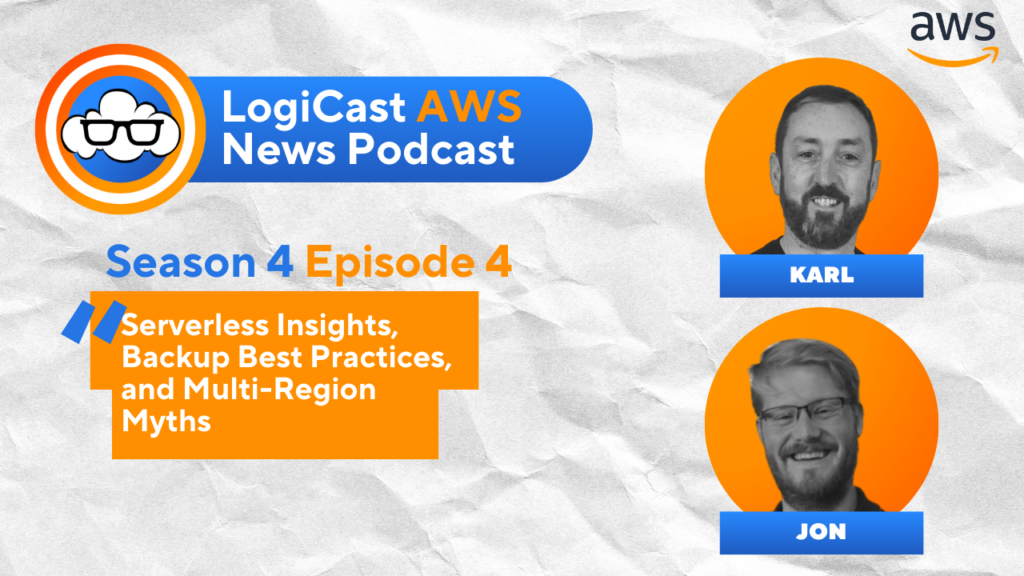
Logicata AI Bot
March 26, 2025
The Logicata AI Bot automatically transcribes our weekly LogiCast AWS News Podcasts and summarises them into informative blog posts using AWS Elemental MediaConvert, Amazon Transcribe and Amazon Bedrock, co-ordinated by AWS Step Functions.
In this week’s episode of LogiCast, the AWS News podcast, host Karl Robinson and co-host Jon Goodall of Logicata were joined by returning guest and AWS Hero Johannes Koch to discuss the latest developments in the AWS ecosystem. Despite a relatively quiet news week, the trio delved into several interesting topics, ranging from new features in AWS services to the growing influence of AI in various AWS offerings.
Code Pipeline Enhancements
The discussion kicked off with a focus on the recent announcement that AWS CodePipeline now supports invoking pipeline execution with a new action type. Johannes, as an expert in this area, shared his thoughts on the development.
According to Johannes, CodePipeline has seen several important updates in recent weeks, making the service more usable. He highlighted that this new feature allows users to directly execute other CodePipelines from an existing CodePipeline, which was previously not possible natively.
Johannes expressed some reservations about the implementation, noting that while the feature is welcome, it may not fully address all the challenges users face with CodePipeline. He emphasized the need for better integration and visibility between connected pipelines.
Jon, while not a frequent user of CodePipeline, acknowledged the trend of increasing direct SDK integrations in AWS services, similar to what he’s observed with Step Functions. However, he questioned the extent of the use case for choreographing pipelines together, viewing it as a potential anti-pattern.
Johannes countered this perspective, stating that in enterprise environments, tying together pipelines that perform different steps is quite common. He highlighted benefits such as improved security hardening of pipeline roles and the ability to delegate responsibility for parts of pipelines to different teams and owners.
The conversation touched on the recent announcements regarding CodePipeline’s native deployment capabilities for EC2 and Kubernetes clusters. Johannes pointed out some limitations in these implementations, such as the reliance on SSM for EC2 deployments, which might not be suitable for enterprises that disable SSM for security reasons.
Karl inquired about workarounds prior to this feature, to which Johannes explained that users could previously execute Lambdas or custom commands, or use CodeBuild projects to trigger other CodePipelines using SDKs. However, he noted that these approaches were often clunky and lacked native integration.
The discussion then shifted to the broader strategy behind AWS’s development of CodePipeline and related services. Johannes expressed curiosity about the overall direction, particularly in light of recent announcements and the discontinuation of CodeCommit.
KMS CloudWatch Metrics
Moving on to the next topic, the group discussed a recent AWS Security blog post about how AWS KMS CloudWatch metrics can help users better track and understand KMS key usage.
Jon contextualized this announcement, relating it to recent incidents where users experienced unexpected cost increases due to KMS key usage. He emphasized the importance of understanding KMS key usage patterns and the potential for cost optimization through techniques like caching.
Karl raised a question about the cost implications of using CloudWatch metrics to track KMS usage. Jon clarified that while CloudWatch Logs can be expensive, metrics are generally less costly and shouldn’t be a significant concern in this context.
Johannes expressed surprise that such metrics weren’t already readily available, given the emphasis on built-in observability in many AWS reinvent sessions. He suggested that AWS could have provided more comprehensive solutions, such as CloudFormation templates for deploying these metrics and associated dashboards.
SNS Data Exfiltration Concerns
The conversation then turned to a cybersecurity article discussing how AWS Simple Notification Service (SNS) could potentially be abused for data exfiltration and phishing attacks.
Jon downplayed the severity of this issue, explaining that it’s not so much an abuse of the service as it is using SNS for its intended purpose of sending data. He emphasized that this scenario would require an attacker to already have compromised credentials and access to the environment.
Johannes saw the article as a reminder for users to carefully review their instance profiles and permissions, advocating for the principle of least privilege. He stressed the importance of having purposely fitted roles and permissions, particularly in Kubernetes environments where it’s common to have instance roles with extensive permissions.
Both Jon and Johannes agreed that this scenario underscores the need for proper security practices, including minimizing the use of EC2 instances in public subnets and implementing appropriate network firewalls.
Next-Generation Amazon Connect
The final topic of discussion centered around the introduction of the next generation of Amazon Connect, which incorporates AI-powered interactions to enhance customer relationships and business outcomes.
Jon acknowledged the challenges associated with traditional contact centers, both from a customer and employee perspective. He highlighted the potential benefits of AI in this space, particularly in areas like analytics and post-contact work, where processing large volumes of conversation data can be time-consuming and challenging.
Johannes shared his positive impressions of the previous version of Amazon Connect, noting its ease of setup and integration capabilities. He expressed interest in seeing how the new AI-powered features would enhance the service’s functionality, particularly in areas like decision-making, summarization, and information extraction.
Karl pointed out the potential for AI to improve efficiency in contact centers, especially for large-scale B2C operations. He highlighted examples such as automated follow-up actions and scheduled callbacks, which could significantly enhance customer service quality and reduce human error.
Conclusion
As the longest episode of LogiCast to date, this discussion covered a wide range of AWS developments, with a particular focus on the growing influence of AI across various AWS services. From CodePipeline enhancements to the evolution of Amazon Connect, it’s clear that AWS continues to innovate and expand its offerings to meet the diverse needs of its customers.
While some announcements may seem incremental, they collectively paint a picture of AWS’s ongoing efforts to improve developer experiences, enhance security, and leverage AI to solve complex business challenges. As always, the LogiCast team will continue to monitor and discuss these developments in future episodes.
This is an AI generated piece of content, based on the Logicast Podcast Season 4 Episode 12.





